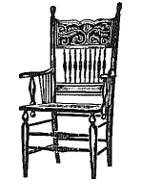Eerdmans justly enjoys a reputation as one of America’s leading Christian publishers; however, as modern Christianity itself becomes increasingly fragmented and secularized, publishing books that try to represent the whole of it, as these two volumes do, becomes increasingly problematic. Though the United States has never been united by a single communion or creed, until quite recently it did enjoy near unanimity on such fundamental doctrines as the Fatherhood of God and on the universal applicability of the Golden Rule and the Ten Commandments. “We are a Christian people,” affirmed the Supreme Court in 1931. As these two works show, that spiritual consensus is crumbling. Now mention of God the Father brings anathemas from feminist theologians, while leading ministers refuse to “impose” any values—even those from the top of Sinai—on anyone.
A few of the contributors to Eerdmans’ Handbook to Christianity in America are disturbed by the spiritual disintegration of the nation: one writer laments that in the 60’s the churches “took up the chorus of selfism”; another perceives that modem “rights” activists have typically had “no theology at all.” But many of them laud the new “liberation” movements, “the new pluralism” with its “moving away from an emphasis on the differences between Christianity and the alternative faiths,” and the leftist polemics of the National and World Councils of Churches. They thus evince as much concern about the decline of Christianity as Nero showed for the burning of Rome.
In the second volume of A Documentary History of Religion in America, Edwin S. Gaustad seeks “to offer enough balance. . . for virtually every taste.” He does, fortunately, include the bracingly conservative theological protest against “captivity to the prevailing thought structures” formulated in 1975 at Hartford under the leadership of the Rev. Richard Neuhaus and sociologist Peter Berger. He also anthologizes this perceptive observation by George Santayana:
As to modernism, it is suicide. It is the last of the concessions to the spirit of the world which half-believers and double-minded prophets have always been found making; but it is a mortal concession. It concedes everything; but it concedes that everything in Christianity, as Christians hold it, is an illusion.
Although he can quote Santayana, Gaustad does not seem able to learn from him: in his overall selection of documents and in his commentary on the Moral Majority, on feminism, and on the no-nukes movement, he reveals a decidedly modern liberal bias. The introduction to a pastoral letter from a Catholic bishop “withholding 50 percent of my income tax as a means of protesting our nation’s continuing involvement in the race for nuclear arms supremacy” (the last document in the collection) is almost adulatory. Half-believers of the sort Eerdmans now seems willing to let edit and write their books may share the fashionable illusion that denying Caesar half of his due is a valid act of contemporary worship. True Christians who know that this concedes to Soviet atheists the right to abolish every Western congregation will recognize that, like other forms of modernism, it is suicide.



Leave a Reply